Berkeley 82 is a small open cluster in northeastern Aquila. It resides on the edge of the dark rift that runs through much of the constellation. This is why the lower right corner has far more visible stars than the upper left portion of my image. WEBDA puts its age at 31 million years. Still, it is old enough to have two stars that have evolved into red giants in that short time. Its distance is just under 3,000 light-years according to WEBDA. I'd have thought that would put it in front of most of the dust of the Milky Way but WEBDA says it has been reddened by just over 1 magnitude indicating the dust from this portion of the rift is apparently rather close to us.
As with many Berkeley clusters, the coordinates of this one vary quite a bit from source to source. The Sky wanted to put it about 3 minutes northwest of its real position. WEBDA shows it about the same north of their position for example. For such a small group how it's position in many catalogs be outside the boundaries of its major stars, I don't know. Unless they are off center from a large faint group of stars not obviously part of the group. But since no two sources agree as to its position I doubt that's the problem. Fortunately, I took this one in the evening just after it was dark enough to start an image so saw The Sky's position error and recentered on the cluster. Though I didn't see this until the first luminance frame came in. Then I forgot to retake that frame so ended up with only 3 luminance frames. Including the first one would have severely cropped the image losing some of the fall-off in star numbers so I went with only 3 frames. Star clusters, being bright, can survive a lower signal to noise ratio than can nebulae and galaxies with their faint outer regions.
There may be another cluster to the upper right of Berkeley 82. SIMBAD shows the small group of bright stars there as DSH J1910.8+1312. DSH stands for Deep Sky Hunters. They are cataloging all types of previously unknown deep-sky candidate objects. So is this a true cluster or just a bright asterism? I'm voting for it being an asterism. Hipparcos puts the brightest star at only 54 light-years from us. It's highly doubtful it could be a member of any cluster-like object this small. But could the other stars be part of a true cluster? I couldn't find anything on them to help decide this.
This image is at 1.5" per pixel rather than my usual 1" per pixel.
14" LX200R @ f/10, L=3x10 RGB=2x10', STL-11000XM, Paramount ME | 
BERK82L3X10RGB2X10-67.JPG
| BERKELEY 83 is a small but rather well-defined cluster in northern Vulpecula on the edge of the dark rift that runs through the Milky Way in this part of the sky. It appears rather reddened by the dust of the rift though it could be due to its stars being quite old. I can't find much on it at all. While my The Sky's basic database has it they have the position rather wrong. They point about 10 minutes west of its real position. That would have been a problem if I'd been doing this one automatically as it would have been near the right edge of the frame. Fortunately, my framing shot showed it faintly on the edge and I was able to center it for my image. Since it is in an area filled with stars I did break my rule and enhanced it a bit more than the rest of the starfield. Also, since the resolution wasn't needed I'm displaying the full image at 1.5" per pixel rather than my usual 1" per pixel.
While WEBDA did list it they too had a slightly wrong position for it. In fact, many of the Berkeley clusters have positional errors at least in their images which usually put the cluster well off center. They have a different error than The Sky did. Oddly their position data doesn't match their image. Neither are right but both are a lot closer than The Sky 6 was. I measure it at 20h 1m 25s +29d 38m 33s for those looking for it.
This image is at 1.5" per pixel rather than my usual 1" per pixel.
14" LX200R @ f/10, L=4x10' RGB=2x10' STL-11000XM, Paramount ME | 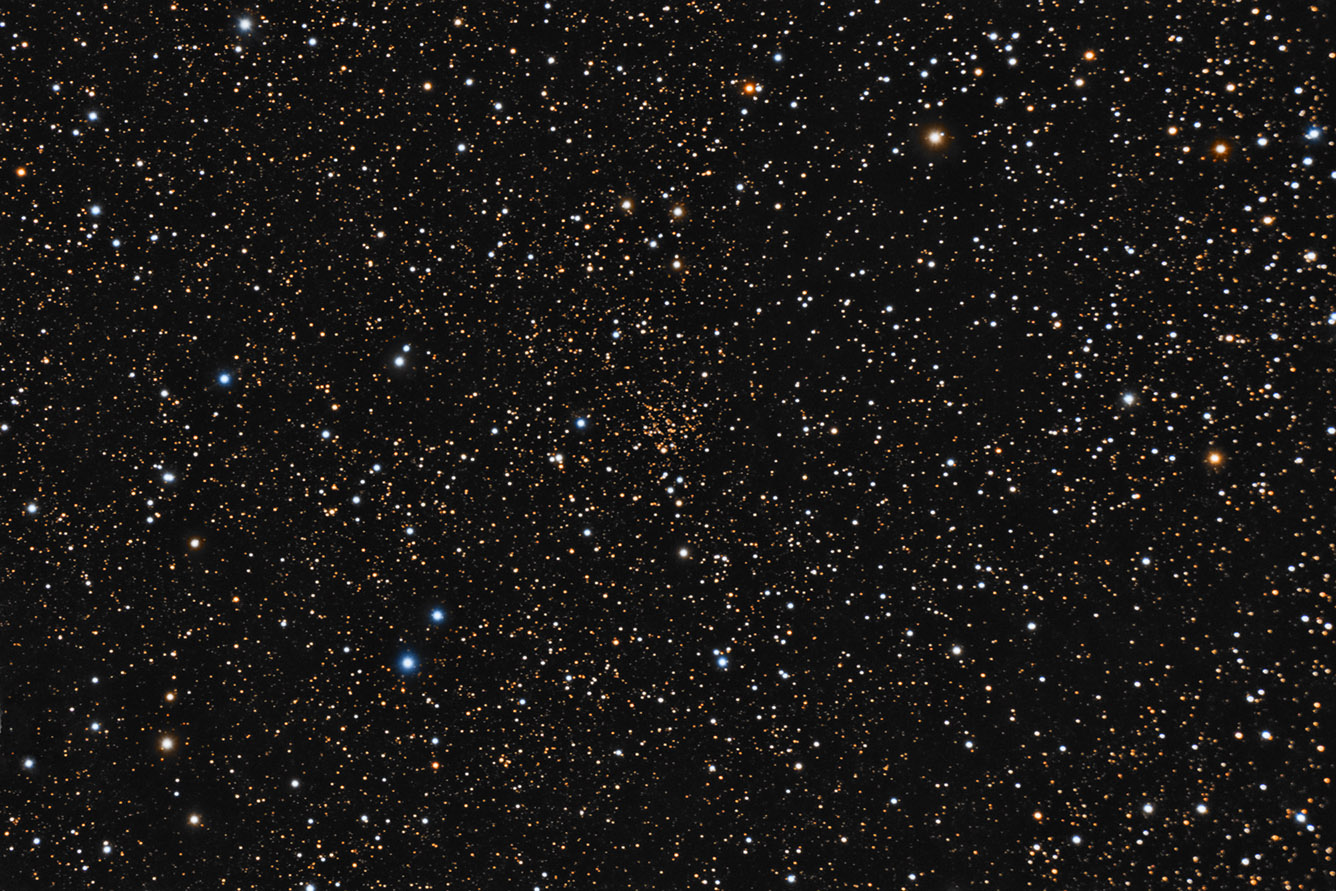
BERK083_L4X10RGB2X10-67.JPG
| Berkeley 85 is an open cluster in Cygnus about 1.5 degrees northwest of the famous Crescent Nebula, NGC 6888. I've seen it in many wide field images of the nebula. That's one reason it made my to-do list. WEBDA puts it at about 5,700 light-years with an age of about 1 billion years and about three-quarters of a magnitude of reddening due to galactic dust between us and the cluster.
I'd wanted to fully include another open cluster Dolidze 40 to the northwest (upper right) but when I took the framing shot I saw horrid reflections from 34 Cygni, a 4.76 magnitude B2 star directly north of the cluster and out of the frame. I finally ended up cutting off part of the cluster to get rid of the reflections -- or so I thought. Turned out fainter ones were all throughout the image. I ended up losing the background H alpha signal removing them. WEBDA recognizes Dolidze 40 but has nothing on it but position.
The dark nebula to the southwest of Berkeley 85 is DOBASHI 2317. The dark nebula to the northeast of the cluster is DOBASHI 2323.
The scattering of bright blue giant stars somewhat hides the clusters. I toned them down but they still photobomb the image.
This image is at 1.5" per pixel rather than my usual 1" per pixel.
14" LX200R @ f/10, L=4x10' RGB=2x10', STL-11000XM, Paramount ME | 
BERK85L4X10RGB2X10-67.JPG
| Sometimes I wonder why I put an object on my to-do list. This is one of those times.
Berkeley 86 is somewhere in my image. Just where I don't know. WEBDA often misses the right position by several minutes. Checking various sources I find different locations. The one paper I found on it seems to show it about the center of my image which was based on an average of the various positions I found. The paper is at http://iopscience.iop.org/article/10.1086/130853/pdf It has numbered some stars it considers part of the cluster.
WEBDA says it is 3600 light-years distant, is 13 million years old and reddened by 0.9 magnitudes.
With a paper and WEBDA seeing the cluster I have to assume it is real. All I see are various asterism groupings that change each time I look at it. After a while, even those vanish to my eye.
A couple weak dark nebulae appear to wind through the frame. I couldn't find any listed at SIMBAD however.
Reproduced at 1.5" per pixel rather than my usual 1" as that would needlessly enlarge the image. Why I took only 1 blue frame is unknown. Since there was no satellite in it that worked out fine.
This image is at 1.5" per pixel rather than my usual 1" per pixel.
14" LX200R @ f/10, L=4x10' RG=2x10' B=1x10', STL-11000XM, Paramount ME
| 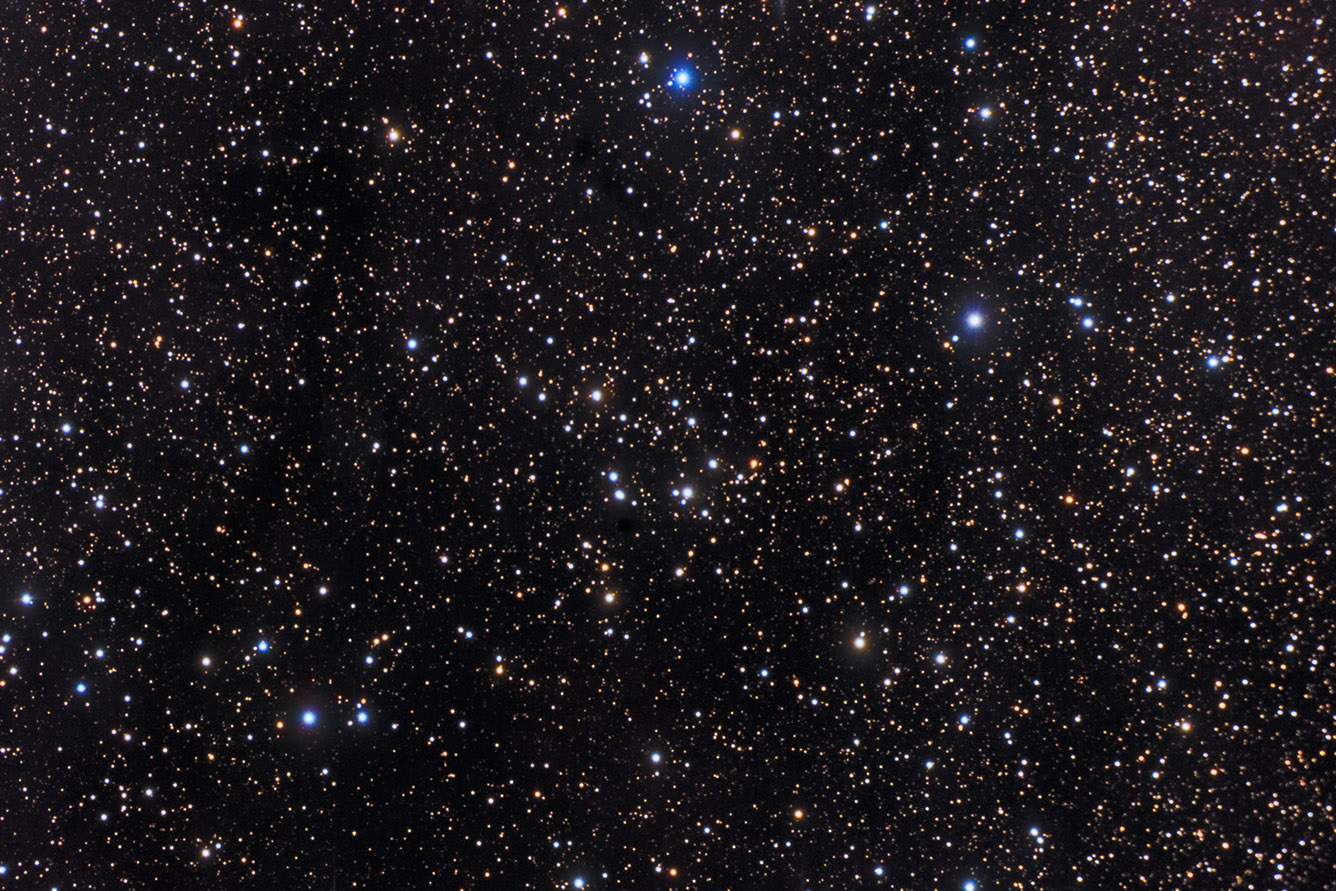
BERK86L4X10RG2X10B1X10-67.JPG
| Berkeley 93 is a very distant open cluster embedded in a dust cloud about 18,250 light-years distant. It is located in Cepheus. It is thought to be larger than seen with the fainter stars hidden by the dust. The bright red star in its center is a carbon star, about C5. The characteristics of such a carbon star are well known and were used to derive the cluster's distance. While it is a variable star its type is unknown, at least at the time of the paper I read on it. http://adsabs.harvard.edu/cgi-bin/bib_query?1994AJ....107.2101S
It seems no one knows the correct position of this cluster. When I let The Sky slew to it I knew I was in trouble. So I checked WEBDA and found the cluster out of their image but the coordinates were different. I then used those of the POSS server that were yet again different. Having to get to bed for an early alarm call I went with that though knew it wrong as well.
The Sky's position 21h 57m 06s +63d 56' 00"
WEBDA 21h 56m 12s +63d 56' 00"
POSS and SIMBAD 21h 55m 48s +63d 56' 42"
Plate solve of my image 21h 55m 27s +63d 56 14"
The carbon star referred to in the paper is the brightest and reddest star in the cluster so easy to find. Like with Berkeley 85 there was a bright star out of the frame that sent a nasty set of reflections into the image. This time it was south of the frame and red. Red normally isn't a problem so I ignored it, but was this time There were some faint H alpha clouds in the image but I had to sacrifice them to the reflections which just faded into the faint nebulosity making their removal pure guesswork as to where they met and what was under the reflections.
This image is at 1.5" per pixel rather than my usual 1" per pixel. The cropped image is 1" per pixel, however.
14" LX200R @ f/10, L=4x10' RGB=2x10', STL-11000XM, Paramount ME
| 
BERKELEY93L4X10RGB2X10-67.JPG
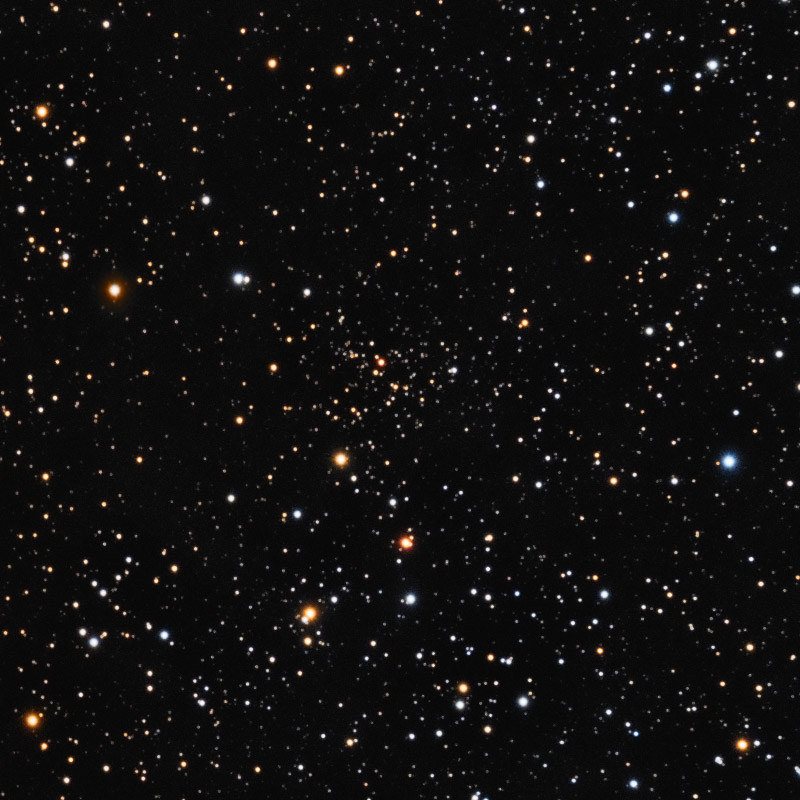
BERKELEY93L4X10RGB2X10CROP.JPG
| Berkeley 96 is an open cluster in northern Lacerta. It is 10,000 light-years distant, reddened by 0.63 magnitudes and is quite young at 6.6 million years. That explains the rather blue stars even with the reddening. While most catalogs put it where I did in the center of my image, WEBDA moves it about 4 minutes west. There's a chain of small stars there that are mostly orange. That can't fit a cluster as young as they say. I have to assume they got the position wrong. Their image puts the cluster on the left edge of there 10'x10' image.
There are about 3 galaxies in the image listed at NED but none have any information, not even a magnitude let alone distance data. They are mostly star-like. For that reason and the lack of any asteroids, I didn't prepare an annotated image. The cropped image is at 1" per pixel but the full frame is at 1.5" per pixel to hold down the bandwidth. Also, no detail is lost with the lower image scale and it is still over a half meg in size.
This image was taken during a hole in the smoke so went together very easily. That is the three color images were in a hole. The second round of color was unusable. The luminance dimmed about a magnitude. But with good color data for a change, it was easy to process if I ignored it didn't go all that deep. Little would have been seen if it had so this is one smoke image that turned out well.
14" LX200R @ f/10, L=4x10' RGB=1x10', STL-11000ME, Paramount ME
Rick | 
B96L4X10RGB1X10-67.JPG

B96L4X10RGB1X10.JPG

B96L4X10RGB1X10CROP.JPG
| Berkeley 103 is an obscure, little studied, open cluster in Cassiopeia. WEBDA and the one paper I found on it agree that it is about 6850 light-years distant +/- 300. They put its age at about a half billion years. They also say it is reddened by 1 magnitude. Amazing agreement unless WEBDA is using this paper for its data.
The dark nebula to the bottom right is DOBASHI 3552.
The color of this one is highly suspect as it was taken through severe smoke that was costing me 1.5 magnitudes or more. This severely reddened the image forcing me to push blue farther than I ever had and created strong red halos around even blue stars. Removing all of them was difficult and led to other issues. I suspect the image is still too red. With no color image of this one that I found other than a pseudo color image using red and blue POSS plates at SIMBAD, I ended up "adjusting to taste" as even eXcalibrator left the image severely red. I knew the smoke was an issue but didn't realize how bad it was until I went to process this one.
I suspect the bright white star near its center is not a cluster member but found nothing on it. It's just my guess. This is one most catalogs get the position correct for but The Sky missed by about 5 minutes. I saw the problem when setting up and recentered using WEBDA's coordinates. Why this happenes so often with Berkeley clusters I don't understand.
This image is at 1.5" per pixel rather than my usual 1" per pixel.
14" LX200R @ f/10, L=4x10' RGB=2x10', STL-11000XM, Paramount ME | 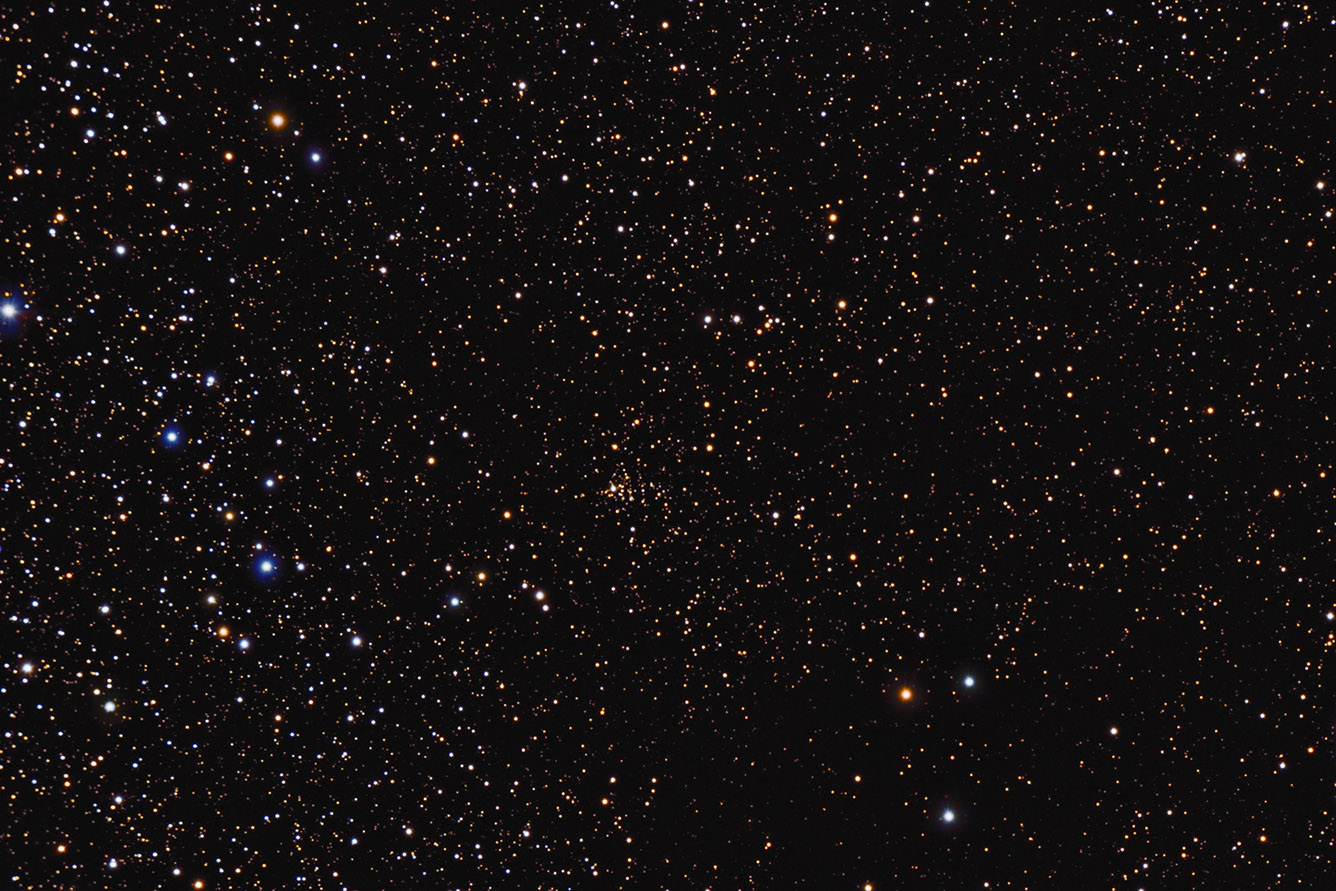
BERKELEY103L4X10RGB2X10-67.JPG
| After hearing reports that it had split in two and speculation that it was breaking up like P17/Holmes a few years ago I had to take a look. It passed perihelion last year at about over 2.2 AU so never came close to the sun. My image shows that it did indeed split off a small piece which is now "trailing" the nucleus being pushed further from the sun by the solar wind. This would indicate it is an extremely low-density object unless it got a push this way when it split off which I doubt. The main comet also seems rather bright for a comet that is now nearly 3 a.u. from the sun. But it certainly is showing no sign of turning into a Holmes-like comet. Dozens of pieces were seen in that case inside the main coma not one piece following it as we have here. It was a bit fainter than 11th magnitude when this image was taken on March 21, 2010. I used 20 2 minute frames tracking on the comet. My camera takes about 10 seconds to download a frame. This gap causes the star trails to have many small gaps. The 5 minute gap is due to my thinking I'd set it for 20 frames but had it for 10 instead. Took me a bit to realize it had stopped after 10 as instructed. I then took another 10.
14" LX200R @ f/10, L=20x2', STL-11000XM, Paramount ME | 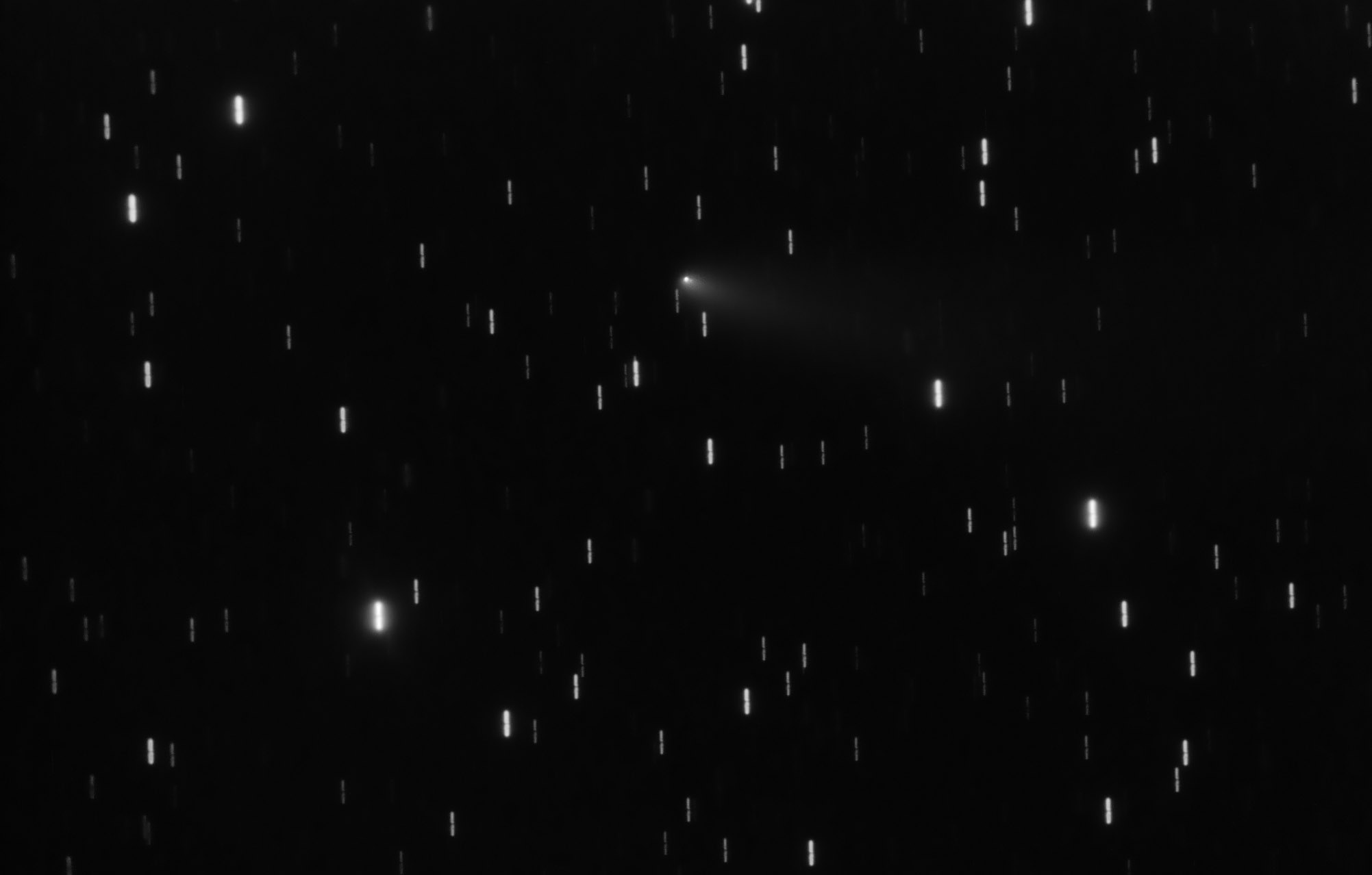
SLIDING_SPRING_C2007Q3_L=20X2.jpg
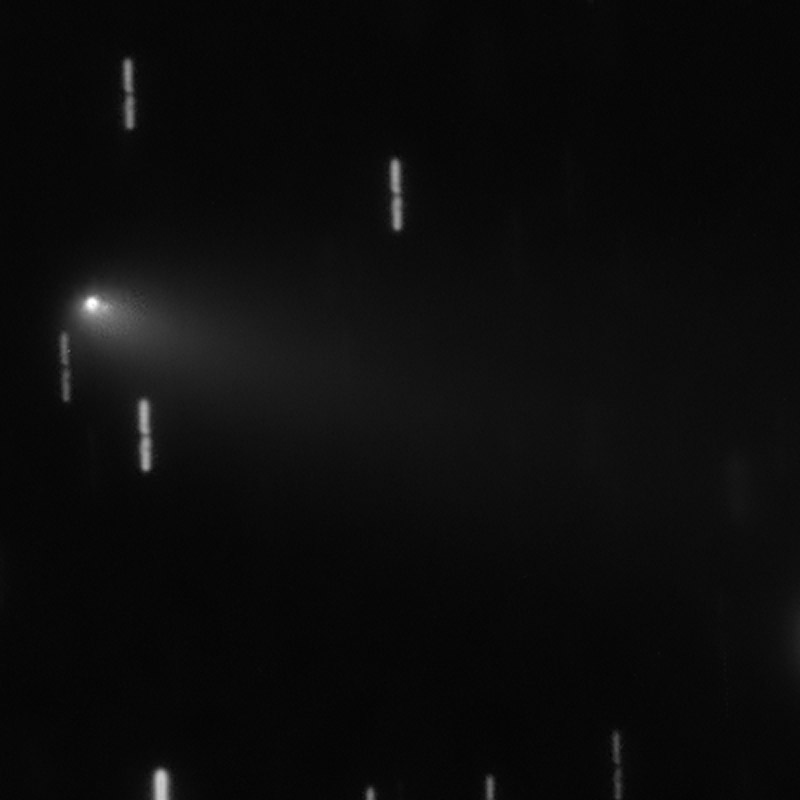
SLIDING_SPRING_C2007Q3_L=20X2crop2x.jpg
| While at first glance the image may appear to be taken someplace in our Milky Way it is actually in another Milky Way. The lack of resolution of background stars should have given this away. The image is looking deep into M31, the Andromeda Galaxy. We'll be getting a real close up look at it in a few billion years when we collide and probably merge with it.
The cluster I centered on is often seen in shots of the galaxy as a tiny star, sometimes the HII shows it as pink to the west of M32. Even the full image is too narrow angle to show the edges of the galaxy.
I'd picked up a few stars in the cluster in a previous image taken about 5 years ago. Ever since I've tried unsuccessfully to resolve it until this short lived super night of August 29, 2008 UTC. Oh yes, it's named. It has several. In the "Atlas of the Andromeda Galaxy" it is cluster C179. For those who've never heard of the Hodge atlas, it is online at http://nedwww.ipac.caltech.edu/level5/ANDROMEDA_Atlas/Hodge_contents.html
C179 is one of the largest star clusters in an HII region in the galaxy. I especially liked the arc of blue stars above it. Is there some reason for this arc? Wish I knew. Was it created by radiation pressure from the core stars? Just a random pattern? I have no idea. That's what it attracts me. NED lists two catalog names for it MESSIER 031:[BA64] 289 and MESSIER 031:[PAV78] 258. Though these refer to the HII region rather than the cluster. The Atlas mentioned above doesn't have a section for HII regions so apparently, we need both to fully cover it. Both are part of the stellar association the atlas calls A22.
I've prepared a partial annotated image using the designations in the atlas and NED when the atlas didn't include the object. C is a cluster, G a globular cluster and A a stellar association. D is for dark nebula but I didn't include any of these in the annotated image. Since stellar associations are hard to identify I've not labeled many of them either. Both are rather vaguely defined so best seen using the atlas. C179 is on Chart 5 http://nedwww.ipac.caltech.edu/level5/ANDROMEDA_Atlas/Chart5.html. The image does extend into 3 as well. You can spend a day identifying all the features. The charts were rather small on my monitor and I had to blow them up to see them clearly. While most fuzzy blobs are identified on the atlas as globular and open clusters I've found several that aren't identified by either the Atlas or NED. I put a question mark beside them. Not all globulars and open clusters are in the atlas, some I only found in NED. Those carry the NED designation. BOL stands for Bologna Globular Clusters. Why some aren't on the atlas I don't know, later data? MLA0469 is an HII region as is [PAV78]274 near it. Only the former is pink. The latter is associated with an open cluster which dominates my color data.
Just like it is easy to get lost in the Milky Way you can get lost in M31 when the image scale is large enough. Having the needed seeing once in 5 years really makes me envious of those few imaging remotely from mountaintops where such seeing is routine. Seeing pinpoint stars at 0.5" is a fantastic sight to this image. I just wish the color data were up to that quality.
Using NED I was also able to find a handful of very faint planetary nebula. All but one were close to the noise level making ID a bit uncertain so I've not listed but two of them, one quite bright on the left edge of the image. Think how bright it must be to be so easily seen over more than 2.5 million light years. Even C179 and its HII region must be a grand sight for those living within a few thousand light-years of it in the galaxy.
While most of my images are at 1" or 1.5" per pixel this one is at 0.5" per pixel.
14" LX200R @ f/10, L=7x10'x1, RGB=4x10'x3, STL-11000XM, Paramount ME Related Designations for C179C179, | 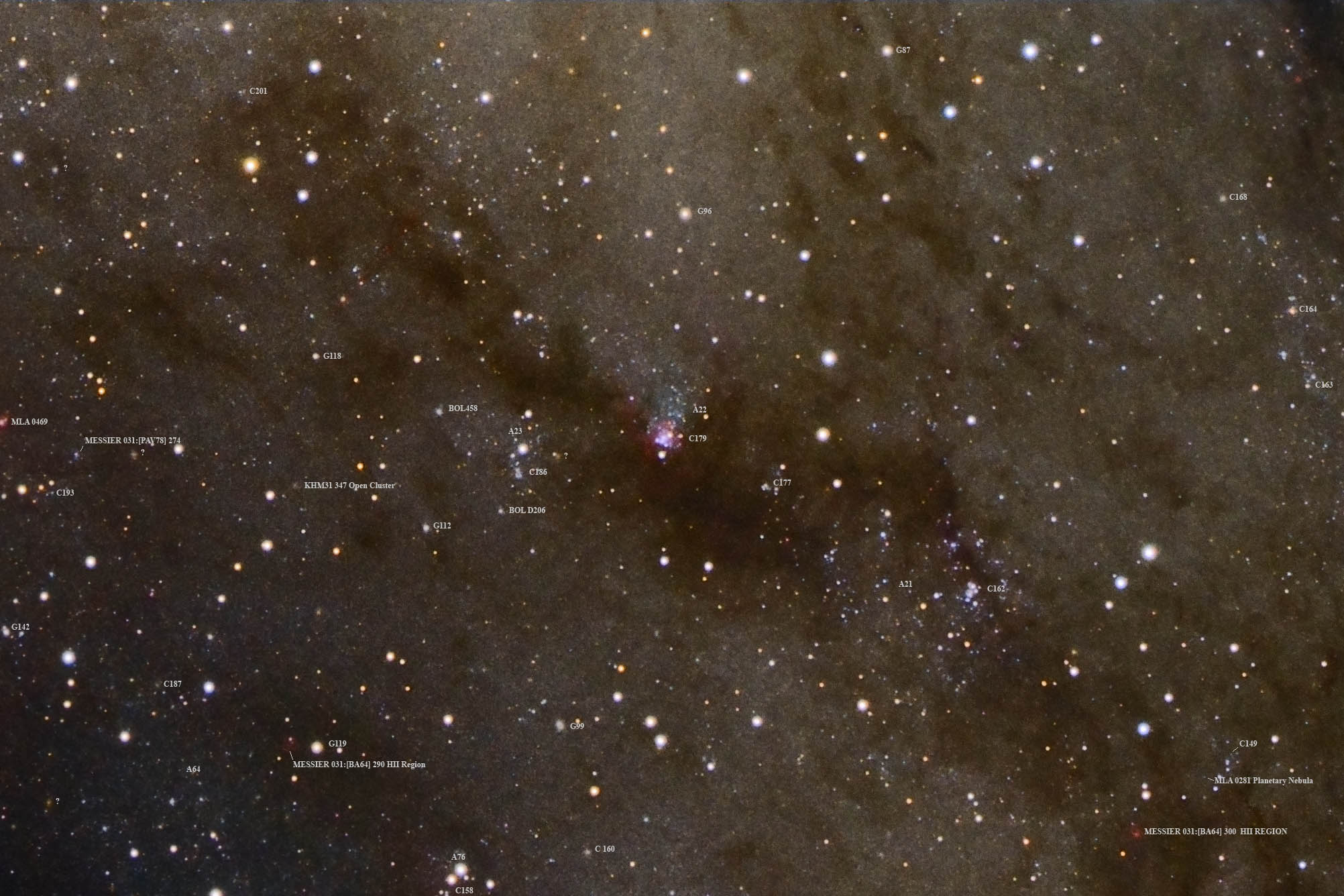
M31-C179-7X10X1RGB4X10X3-ID.jpg
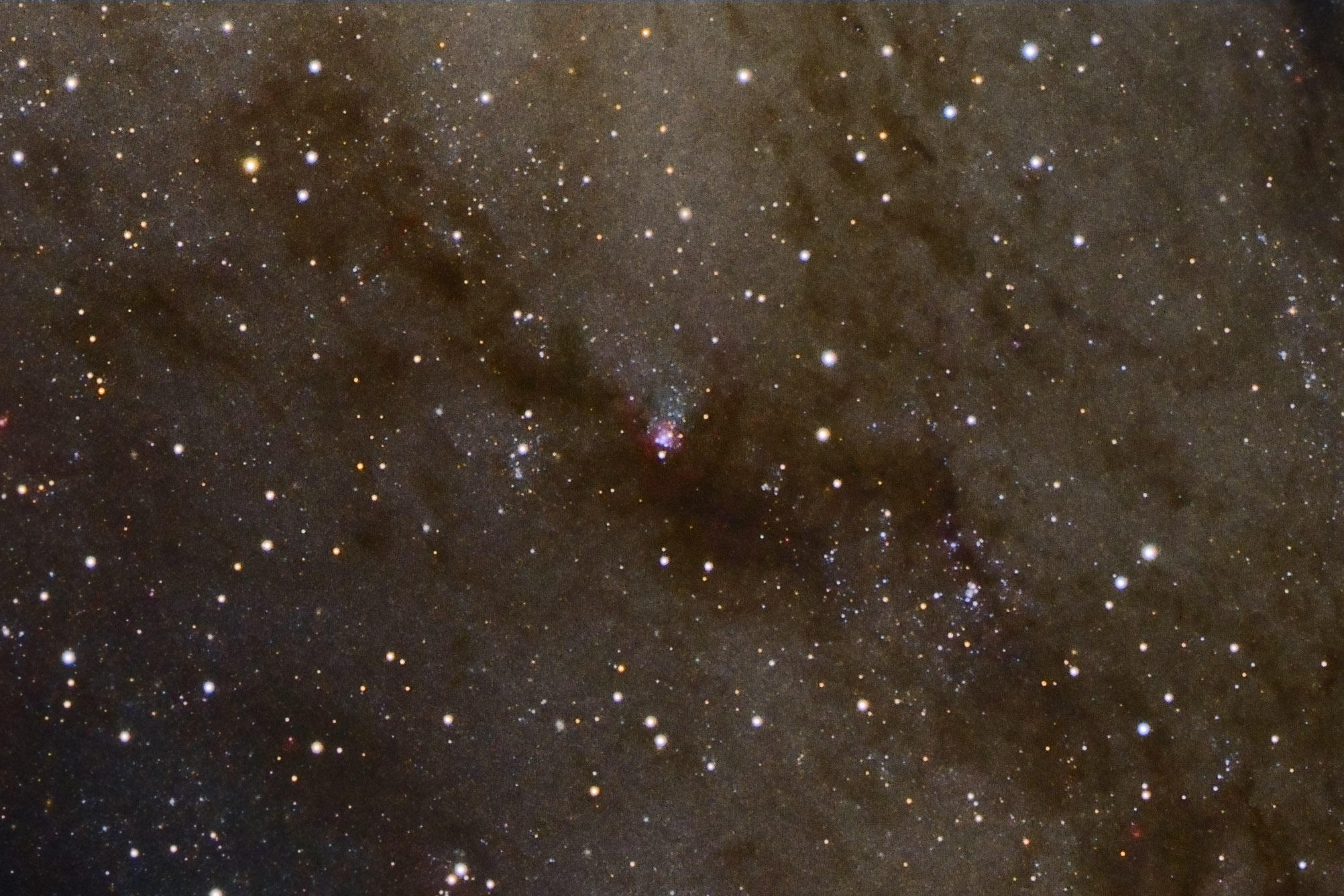
M31-C179-7X10X1RGB4X10X3.jpg
| In late October of 2006, my observatory was just getting up and running when Comet Swan M4 came by the earth in the early evening sky. I had little experience with imaging a comet and none in trying to get a "movie" of it. I had beginner's luck. Not having but a glimmer of how to do it I succeeded beyond my expectations. The comet turned out to be very active on the evening of October 29th UT. It was still a rather bright sky but it was setting in the west so I gave it a try before it set behind my roof. I took 30 one minute shots which I then stitched together into a 4+ megabyte animated GIF. I was hoping to get its motion through the stars. I got far more.
I did succeed in showing that the tail of a comet doesn't necessarily point behind its direction of travel as many believe including some textbooks used in public schools. Instead, it is pushed back by the solar wind so, at least at first, points away from the sun. This is especially true of the ion tail which is made up of ionized gasses so also responds to the sun's magnetic field. Comet Swan had a very active ion tail. So active my animation caught the gasses flowing away from the head of the comet and down the tail. Even in 30 minutes, the motion was obvious. This came as a total surprise. Since then I've made movies of several other comets but none showed any motion in the tail.
Also, the tail responds to the sun's magnetic field. If a comet's orbital motion carries it across a strong field line and into another the ion tail can disconnect and flow away as a new one develops. This happened to Comet Swan a few hours after my animation stops. It stopped because it was right over my chimney and my wife not knowing I was pointed right there lit newspapers to start up the fireplace as we heat with wood in winter evenings after turning off the gas furnace. The sparks from the newspaper made further frames useless. Not that it mattered as the comet went behind the chimney a few minutes later.
Note however there are many short streamers coming from the head of the coma. In the first frames these are along a rather wide arc of the coma but by the end, they are narrowing down quite a bit. This likely was a precursor to the tail disconnect a couple hours later. If I was a few time zones west I might have caught the disconnect in the movie. No one did and as far as I know, no one caught any of the motion in the tail this one did.
I had been asked if I could make a movie of it to show the tail didn't flow behind the comet. I'd likely never have taken this without the request as I had no idea how to do it. The professional astronomer who asked me if I could do the movie was thrilled with the animation and said I should submit it to NASA's Astronomical picture Of the Day website. Not going through the right channels I was ineligible for an APOD but they did accept it for a link. You can see the short version I submitted at https://apod.nasa.gov/apod/ap061106.html then click on the text link "move outward" to see my animation. This short version skipping frames makes it easier to see the pinching of the streamers prior to the tail disconnect. The movie is used by many science teachers so is likely my most successful image and it was taken only by beginner's luck and in mostly ignorance rather than knowledge.
Note one frame is missing so it jumps slightly in the full version. My wife's first attempt to start the fire failed but not before sending up some nasty sparks. I didn't see the frame as it came in so didn't stop her from trying again a few minutes later. I had to pull that frame. Since my camera needs a few seconds to download each image and start another the movie covers about 33 minutes of time, not 30. Note two a few galaxies pass through the tail as the sky moves to the left due to the comet's orbital motion. It was too far west the next day so I couldn't try again.
14" LX200R @ f/10, 29x1' binned 3x3 (30 taken, one unusable), STL-11000XM, Paramount ME | 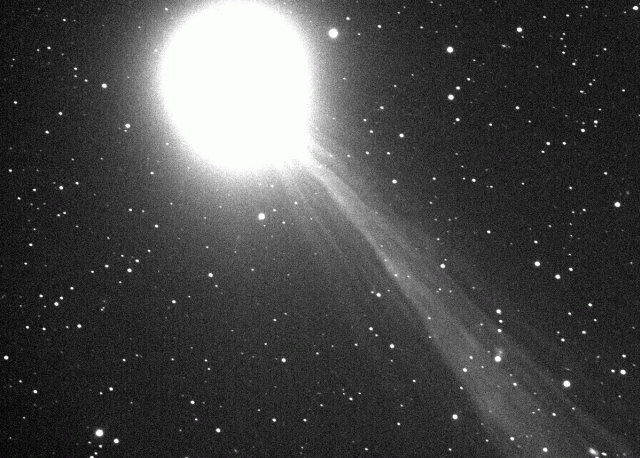
SWAN_10-28-06_0104UT_3X1_B3X3Large.gif
| 













